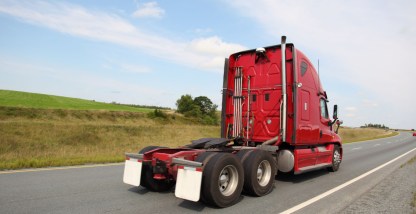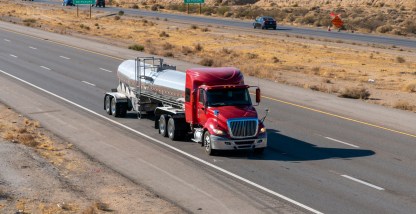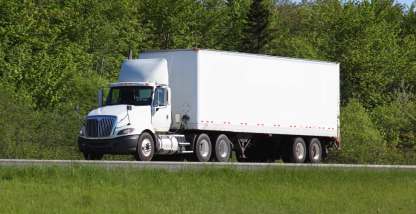By Clifford Petersen
As I left off in my last blog post, I promised to approach the two alternatives to becoming a successful owner operator. First, you can inherit your equipment and authority. And second, you can go out and buy it.
Some of the companies you see on the road today were inherited from a trucker who started a business, built it up, and passed on to their children.
Others are simply company drivers who want to start their own business and get their own authority so they can have the potential to earn more. There’s also the freedom to set your own schedule and be on the road when it’s convenient for you.
As an owner-operator, one of the many decisions you must make is determining whether you want to lease your truck, among other things.
Here are seven things you need to know if you’re interested in becoming an owner operator.
1. Leasing your truck vs. buying at a dealership
Some owner-operators buy a truck and lease it onto an established carrier. Others get their own authority and become a true, independent operator.
Trucking is a very high-risk operation. That’s the reason for the high price. Many banks will not back a driver, especially a new owner-operator, so financing will go through the dealerships.
If you want to buy your truck from a dealership, you first must have the credit to do so. If it’s your first truck, you can expect to come up with at least 25% for a down payment.
2. The cost of insurance
Just like when you purchase a regular car, you’ll need to have your insurance in place before you can even drive the truck off the lot.
This can be expensive, and factors for your premium may depend upon your experience as a driver and how many trucks you are buying.
Your options may be limited. There isn’t a wide variety of insurance agencies in the game. When I was shopping around for insurance years ago, one company wanted me to pay a year’s worth of insurance upfront. Insurance costs came out to $24,000 for a used, five-year-old truck.
Another company allowed me to make monthly payments at $1,200 a month. They did offer a discount for pre-paying the year in six-month segments.
3. The type of operation you want to run
Before taking these steps, you should know what your niche will be and the kind of operation you want to run. This should be determined by your experience and your knowledge of freight rates in that niche.
There are many types of operations. Which type you choose depends on you and how you’ve chosen to set yourself apart from the pack.
Don’t be afraid to carve out your own niche. Just know that it may take more diligence and perseverance to make it work.
4. Choosing your truck
The next step in the decision process is picking the right truck and trailer for your operation. Specifications are critical at this point. Before shopping around for a truck, ask yourself if you want a used truck and trailer or a new one.
If you need a truck and trailer for the heavy haul, your truck needs to be geared and set up for it. You should also explore going into the reefer or dry van operation. If that’s the case, set up your truck for the best possible fuel advantage.
5. Calculating your truck’s MPG
I run a 2018 Kenworth T680 with an automatic transmission. The truck also has a 500 Paccar engine and 2.64 rears, in a dry van operation. That setup offers me the chance to pull down very good MPG. If I keep my miles per gallon above eight, it pays for itself.
6. How to get your authority
Once you have made these critical decisions, you need to file for your authority.
As I pointed out, you’ll need startup money for insurance, permits, equipment, and more. You’ll also need money for registration in a drug and alcohol testing program.
Set aside some cash runway before becoming an owner operator
As a Boy Scout and a Marine, I’m a firm believer in preparing for the worst.
The Owner-Operator Independent Drivers Association (OOIDA) recommends that everyone set aside at least 60 days of operating capital.
I recommend you set aside at least six months’ of operating capital.
It can take up to 90 days to receive payments for services rendered. By doing your due diligence, you can weed out the type of companies that have a reputation for late payments.
I’ve known drivers who’ve had only 30 days of capital. They’ve run their day-to-day off cash advances from the broker. I don’t recommend it..
Haul loads for broker vs shipper manufacturer
This brings me to another decision that owner-operators must make. Ask yourself if you’ll haul loads for a broker or a private shipper manufacturer. Do your due diligence to know their average rate of pay and credit ratings.
7. Set up IFTA and permits
After that, you’ll need to set up your IFTA and Unified Carrier Registration (UCR permit) and pay your Heavy Highway Use Tax (2290). Some states also require state-issued permits if you’re going to do business in that state. States such as Kentucky, New York, New Mexico, and Oregon require a permit and a bond.
You’ll also need an Intrastate Authority. Many states require an additional authority if you’re picking up and delivering loads within their borders.
This all requires money. Be prepared for these expenses before you’ve picked up and delivered your first load.
Becoming an owner operator — the bottom line
Beyond ensuring you have enough money to get started, make sure you talk to other drivers who’ve started their own businesses. Have a list of questions ready to ask.
Motive has an in-depth guide that shows you how to start your own trucking business. Download it for free.







